|
| |||||||||||||||||||||||||||||||||||||||||||||||||||

| ||||||||||||||||||||||||||||||||||||||||||||||||||||
|
FAST '04 Paper
[FAST '04 Technical Program]
A framework for building unobtrusive disk maintenance applicationsCarnegie Mellon University Contents
AbstractThis paper describes a programming framework for clean construction of disk maintenance applications. They can use it to expose the disk activity to be done, and then process completed requests as they are reported. The system ensures that these applications make steady forward progress without competing for disk access with a system's primary applications. It opportunistically completes maintenance requests by using disk idle time and freeblock scheduling. In this paper, three disk maintenance applications (backup, write-back cache destaging, and disk layout reorganization) are adapted to the system support and evaluated on a FreeBSD implementation. All are shown to successfully execute in busy systems with minimal (e.g., less than 2%) impact on foreground disk performance. In fact, by modifying FreeBSD's cache to write dirty blocks for free, the average read cache miss response time is decreased by 12--30%. For non-volatile caches, the reduction is almost 50%. 1 IntroductionThere are many disk maintenance activities that are required for robust system operation and, yet, have loose time constraints. Such ``background'' activities need to complete within a reasonable amount of time, but are generally intended to occur during otherwise idle time so as to not interfere with higher-priority application progress. Examples include write-back cache flushing, defragmentation, backup, integrity checking, virus scanning, report generation, tamper detection, and index generation. Current systems use a variety of ad hoc approaches for such activities. Most trickle small amounts of work into the storage subsystem, either periodically or when an idle period is detected. When sufficient idle time is not available, these activities either compete with foreground requests or are not completed. More importantly, trickling work into a storage subsystem wastes significant disk scheduling opportunities---it restricts the scheduler to only considering a small subset of externally-chosen requests at externally-chosen points in time. Most background activities need to read or write substantial portions of the disk, but do not have particular ordering requirements. As a result, some implementors try hard to initiate the right requests at the right times, introducing substantial complexity but, usually, only minor improvement. This paper describes an alternate approach, wherein background activities are exposed to the storage subsystem so that it can schedule associated disk accesses opportunistically. With the storage subsystem explicitly supporting priorities, background applications can safely expose work and trust that it will not interfere with foreground activity. Doing so allows the scheduler to use freeblock scheduling and idle disk time to complete background disk accesses in the most device-efficient manner. Freeblock scheduling[Lumb00] predicts rotational latency delays and tries to fill them with media transfers for background tasks. As the set of desired disk locations grows, so does the ability of a freeblock scheduler to utilize such latency delays. The same is true for non-intrusive use of short periods of idle time. Combining rotational latency gaps with short and long periods of idle time, programs designed to work with storage-determined ordering can make consistent progress, without affecting foreground access times, across a wide range of workloads and levels of activity. This paper describes a framework for background disk activities, including application programming interfaces (APIs) and support for them in FreeBSD. In-kernel and system call APIs allow background applications to register ``freeblock tasks.'' Our freeblock subsystem replaces the generic SCSI driver's disk scheduler, utilizing both freeblock scheduling and any idle time to opportunistically complete freeblock requests. The APIs are explicitly asynchronous, and they encourage implementors to expose as much background work as possible. For example, dynamic buffer management allows freeblock tasks to register a desire to read more disk space than fits in main memory. Just-in-time locking avoids excessive holding of buffers, since freeblock writes may be pending for a long time. Rate control avoids memory exhaustion and wasted disk scheduling efforts for applications without sufficient CPU time or network bandwidth. We describe the conversion of three disk maintenance tasks to use this infrastructure: scanning of disk contents for backup, flushing of write-back caches, and reorganizing disk layouts. Well-managed systems perform periodic backups, preferably without interfering with foreground activity. Backup is an excellent match for our framework, often reading large fractions of the disk; a ``physical'' backup does so without interpreting the file system structures and can be made order-agnostic. We implemented such a physical backup application that uses the freeblock subsystem to read disk blocks. Physical backup of a snapshot that covers 70% of an always-busy 18GB disk can be completed in a little over one hour with less than 2% impact on a foreground workload. Almost all file servers and disk array controllers use write-back caching to achieve acceptable performance. Once updates are decoupled from application progress, they become a background activity appropriate for our framework. In our evaluations, we find that approximately 80% of the cache flushes can usually be eliminated, even when there is no idle time, reducing the average disk read response time by 15-25%. For low read-write ratios (e.g., 1:3--1:1), only 30--55% of the flushes are eliminated, but the read response time reductions are still 15--30%. Interestingly, when emulating a non-volatile cache, which eliminates FreeBSD's 30-second limit on time before write-back, almost all flushes can be eliminated, improving read response times by almost 50%. Over time, allocated storage space becomes fragmented, creating a desire for defragmentation. Also, there have been many proposals for periodically reorganizing disk layouts to reduce future access times. Both require that disk blocks be shuffled to conform to a new, preferred layout. Our evaluations show that, using our framework, it is possible to reorganize layouts quickly and with minimal impact on foreground workloads. The remainder of this paper is organized as follows. Section 2 discusses disk maintenance tasks, freeblock scheduling, and related work. Section 3 describes in-kernel and application-level APIs for background disk tasks. Section 4 describes three disk maintenance applications and how they use the APIs. Section 5 briefly describes the freeblock subsystem and its integration into FreeBSD. Section 6 evaluates how well the three applications work when using the framework. 2 Background and related workThere are many disk maintenance activities that need to eventually complete, but that ideally progress without affecting the performance of foreground activity. This section describes how such activities are commonly implemented, how a freeblock subsystem can help, and related work. Characteristics and approaches: Disk maintenance activities generally have long time horizons for completion, allowing them to have lower priority at any instant than other applications running on a system. As a result, one common approach is to simply postpone such activities until expected off hours; for example, desktop backups are usually scheduled for late nights (or, early in the morning for CS researchers). For less sporadically-used systems, however, the lower priority must be handled in another way. Another common approach is to spread background requests over time so as to reduce interference with foreground work; for example, some caches flush a fraction of the dirty blocks each second to reduce penalties associated with periodic full cache flushes[Carson92]. More aggressive implementations explicitly identify periods of idle time and use them to service background work. Of course, identifying idle times requires effort---the background activity must be invoked in the system's critical path---and assumptions about any proactive storage-internal functions. When using a detected idle period, background activities usually provide only a few requests at a time to the storage subsystem to avoid having a lengthy queue when the next foreground request arrives. This is necessary because current storage systems provide little-to-no support for request priorities. By providing only a few requests at a time, these implementations rob the disk scheduler of opportunities to reduce positioning times. In fact, disk maintenance applications usually need to access many disk locations, and many could be quite flexible in their operation ordering. Some implementors attempt to recapture at least a portion of the lost efficiency by providing requests expected to be fast; for example, a disk array reconstruction task can, after a foreground request completes, generate background requests for locations near the recent foreground request rather than near the most recent background request[Hou93]. Such tricks can provide marginal gains, but still lose out on much of the opportunity and often increase complexity by breaking abstraction boundaries between the application and the disk. Freeblock scheduling: Since disk platters rotate continuously, a given sector will reach the disk head at a given time independent of what the disk head is doing until that time. Freeblock scheduling[Lumb00] consists of squeezing background media transfers into foreground rotational latencies. A freeblock scheduler predicts how much rotational latency would occur before the next foreground media transfer and inserts additional media transfers, while still leaving time for the disk head to reach the destination track in time for the foreground transfer. The additional media transfers may be on the current or destination tracks, on another track near the two, or anywhere between them. In the two latter cases, additional seek overheads are incurred, reducing the time available for the additional media transfers, but not completely eliminating it. Freeblock scheduling, as originally proposed, combines nicely with idle time usage to provide disk bandwidth to background tasks across a wide range of foreground usage patterns. In addition to detecting and using lengthy idle time periods, low-level scheduling can allow short, sporadic idle periods to be used with minimal penalty. Throughout this paper, we use the term freeblock scheduling to refer to this more complete combination of the scheduler that works well when the system is busy with the scheduler that utilizes idle time. Freeblock scheduling is a good match for many disk maintenance activities, which desire large numbers of disk blocks without requiring a predetermined order of access. Properly implemented, such activities can provide much freedom to a scheduler that opportunistically matches rotational latency gaps and idle time bursts to desired background transfers. Related work: Lumb et al.[Lumb00] coined the term ``freeblock scheduling'' and evaluated the use of rotational latency gaps for background work via simulation. The simulations indicated that 20--50% of a never-idle disk's bandwidth could be provided to background applications with no effect on foreground response times. This bandwidth was shown to be more than enough for free segment cleaning in a log-structured file system or for free disk scrubbing in a transaction processing system. Later work by two groups[Lumb02,Zhang02] demonstrated that outside-the-disk freeblock scheduling works, albeit with more than 35% loss in efficiency when compared to the hypothetical inside-the-disk implementation assumed in Lumb et al.'s simulations. In both cases, the freeblock scheduler was tailored to a particular application, either background disk scans[Lumb02] or writes in eager writing disk arrays[Zhang02]. In both cases, evaluation was based on I/O traces or synthetic workloads, because system integration was secondary to the main contribution: demonstrating and evaluating the scheduler. This paper builds on this prior work by describing a general programming framework for background disk tasks and evaluating several uses of it. Note that freeblock scheduling can only be done at a place that sees the raw disk. So, it could be done within a logical volume manager but not above a disk array controller. Inside the array controller would work. Several interfaces have been devised to allow application writers to expose asynchronous and order-independent access patterns to storage systems. Dynamic sets[Steere97], disk-directed I/O[Kotz94b], and River[ArpaciDusseau99] all provide such interfaces. We borrow from these, and asynchronous networking interfaces like sockets, for the APIs described in the next section. There has been much research on priority-based scheduling of system resources. Most focus on ensuring that higher priority tasks get the available resources. Notably, MS Manners[Douceur99] provides a framework for regulating applications that compete for system resources. Such system support is orthogonal to the framework described here, which creates and maximizes opportunities for progress on background disk accesses. More closely related to freeblock scheduling are real-time disk schedulers that use slack in deadlines to service non-real-time requests[Bruno99,Molano97,Shenoy98]; the main difference is that foreground requests have no deadlines other than ``ASAP'', so the ``slack'' exists only in rotational latency gaps or idle time. 3 Background disk I/O interfacesTo work well with freeblock scheduling, applications must be designed explicitly for asynchronous I/O and minimal ordering requirements. An application should describe to the freeblock subsystem sets of disk locations that they want to read or write. Internally, when it can, the freeblock subsystem inserts requests into the sequence sent to the disk. After each desired location is accessed, in whatever order the freeblock subsystem chooses, the application is informed and given any data read. This section describes two generic application APIs for background activities. The first is an in-kernel API intended to be the lowest interface before requests are sent to the storage device. The second API specifies system calls that allow user-level applications to tap into a freeblock subsystem. These APIs provide a clean mechanism for registering background disk requests and processing them as they complete. Applications written to these interfaces work well across a range of foreground usage patterns, from always-busy to frequently-idle. Both APIs talk in terms of logical block numbers (LBNs) within a storage logical unit (LUN); consequences of this choice are discussed in Section 3.4. 3.1 In-kernel APITable 1 shows the in-kernel API calls for our freeblock scheduling subsystem. It includes calls for registering read and write freeblock tasks, for aborting and promoting registered tasks, and for suspending and resuming registered tasks. As a part of the high-level device driver, there is one instance of the freeblock scheduler per device in the system; the standard driver call switch mechanism disambiguates which device is intended. This section explains important characteristics of the API.

Table 1: In-kernel interface to the freeblock subsystem. fb_open and fb_close open and close a freeblock session for an application. Tasks can be added to a session until the application closes it. fb_read and fb_write register one or more freeblock tasks. fb_abort and fb_promote are applied to previously registered tasks, to either cancel pending freeblock tasks or convert them to foreground requests. fb_suspend and fb_resume disable and enable scheduling for all tasks of the specified session. *(callback_fn) is called by the freeblock subsystem to report data availability (or just completion) of a read (or write) task. When a write subtask is selected by the scheduler, *(getbuffer_fn) is called to get the source memory address. Applications begin an interaction with the freeblock subsystem with fb_open, which creates a freeblock session. fb_read and fb_write are used to add freeblock tasks, registering interest in reading or writing specific disk locations, to an open session. Note that the term freeblock request is purposefully being avoided in the API to avoid confusion with disk accesses scheduled inside the freeblock subsystem. Sessions allow applications to suspend, resume, and set priorities (values between 1 and 100, with a default of 20) on collections of tasks. No call into the freeblock scheduling subsystem waits for a disk access. Calls to register freeblock tasks return after initializing data structures, and subsequent callbacks report subtask completions. The freeblock subsystem promises to read or write each identified disk location once and to call callback_fn when freeblock requests complete. On the last callback for a given session, the flags value is set to the value indicating completion. Each task has an associated blksize, which is the unit of data (aligned relative to the first address requested) to be returned in each callback_fn call. This parameter of task registration exists to ensure that reads and writes are done in units useful to the application, such as file system blocks or database pages. Having only a portion of a database page, for example, may be insufficient to process the records therein. The blksize value must be a multiple of the LBN size (usually 512 bytes). In practice, high blksize values (e.g., larger than 64KB for the disks used in our work) reduce the scheduler's effectiveness. Calls to register freeblock tasks can specify memory locations, in the addr_range structure, but they are not expected to do so. If they don't, for reads, the freeblock scheduling subsystem passes back, as a parameter to callback_fn, pointers to buffers that are part of the general memory pool; no memory copies are involved, and the application releases them when appropriate. For writes, the associated getbuffer_fn is called when the freeblock scheduler selects a part of a write task. The getbuffer_fn either returns a pointer to the memory locations to be written or indicates that the write cannot currently be performed. The original reason for getbuffer_fn was to avoid long-held locks on buffers associated with registered freeblock write tasks. Commonly, file systems and database systems lock cache blocks for which disk writes are outstanding to prevent them from being updated while being DMA'd to storage. With freeblock scheduling, writes can be waiting to be scheduled for a long time; such locks could easily be a system bottleneck. The getbuffer_fn callback allows the lock to be acquired at the last moment and held only for the duration of the actual disk write. For example, the free write-backs described in Section 4.2 actually hurt performance when they do not utilize this functionality. Since adding it to the API, we have found that the getbuffer_fn function cleanly supports other uses. For example, it enables a form of eager writing[English92,Wang99]: one can register freeblock write tasks for a collection of unallocated disk locations and bind unwritten new blocks to locations in getbuffer_fn. The disk write then occurs for free, and the relevant metadata can be updated with the resulting location. The non-blocking and non-ordered nature of the interface is tailored to match freeblock scheduling's nature. Other aspects of the interface help applications increase the set of blocks asked for at once. Late-binding of memory buffers allows registration of larger freeblock tasks than memory resources would otherwise allow. For example, disk scanning tasks can simply ask for all blocks on the disk in one freeblock task. The fb_abort call allows task registration for more data than are absolutely required (e.g., a search that only needs one match). The fb_promote call allows one to convert freeblock tasks that may soon impact foreground application performance (e.g., a space compression task that has not made sufficient progress) to foreground requests. The fb_suspend and fb_resume calls allow registration of many tasks even when result processing sometimes requires flow control on their completion rate. 3.2 Application-level APIThe application-level API mirrors the in-kernel API, with a system call for each fb_xxx function call. The main differences are in notification and memory management. Because the kernel must protect itself from misbehaving applications, the simple callback mechanisms of the low-level API are not feasible in most systems. Instead, a socket-like interface is used for both. As with the in-kernel API, an application begins by calling sys_fb_open to get a session_id. It can then register freeblock tasks within the session. For each block read or written via these tasks, a completion record is inserted into buffers associated with the session. Applications get records from these buffers via the one new call: sys_fb_getrecord (buffer); each call copies one record into the specified application buffer. Each record contains the session, addr and flags fields from callback_fn in the in-kernel API, as well as the data in the case of freeblock reads. Note that a copy is required from the in-kernel buffer to the application layer. An alternate interface, such as that used by IO-lite[Pai98a], could eliminate such copies. Like with sockets, the sys_fb_getrecord call can be used for both blocking and polling programming styles. Our experiences indicate that full integration with existing system call mechanisms would be appropriate. Specifically, using the standard file descriptor mechanism would allow integrated use of select() with sockets, from which this interface borrows many characteristics. For example, given such integration, an application could cleanly wait for any of a set of sockets and freeblock sessions to have made progress. A timeout parameter in the sys_fb_getrecord function dictates how long the application will wait if no completion record is currently available. A value of 0 will return immediately (polling), and a value of -1 will wait indefinitely. 3.3 Consistency modelFreeblock tasks may have long durations; for example, a background disk scan can take over an hour. Therefore, a clear consistency model is needed for overlapping concurrent freeblock and foreground requests. Like most low-level storage interfaces, our APIs opt for maximum scheduling flexibility by enforcing a minimalistic semantic with three rules. First, no ordering guarantees are enforced among pending tasks, whether they overlap or not. As with traditional I/O interfaces, applications must deal with ordering restrictions explicitly[Ganger00a]. Second, data returned from a read should have been on the disk media at some point before being returned. Third, a block write can be reported complete when it is on disk or when a concurrent write to the same disk location completes; the latter case is rationalized by the fact that the non-written blocks could have been put on the disk just before the ones actually put there. Given these semantics, a freeblock scheduler can coalesce some overlapping tasks. Of course, data fetched from media can be replicated in memory and passed to all concurrent readers. In addition, completion of a write task to location A allows completion of all pending reads or writes to A because the newly written data will be the current on-disk data once the write completes. As a result, a write is given preference when a set of overlapping reads and writes are pending; a read could be done before the write, but doing so is unnecessary given the consistency model. Note that completing reads in this way requires that applications not be allowed to update the source RAM during the write, since it is impossible to know when the DMA happened in most systems. Alternately, this enhancement could be disabled, as we have observed little benefit from it in practice. 3.4 Consequences of LBN-based interfacesThe freeblock scheduling APIs described interact with driver-level scheduling in terms of LBNs. This simplifies implementation of the scheduler and of low-level disk maintenance tasks, such as RAID scrubbing and physical backup. But, many utilities that access structured storage (e.g., files or databases) must coordinate in some way with the software components that provide that structure. For example, consider a file-based backup application. It could read a directory and register freeblock tasks to fetch the files in it, but it will not know whether any given file is deleted and its inode reallocated between the task being registered and the inode eventually being read from disk. If this happens, the application will backup the new file under the old name. Worse problems can arise when directory or indirect blocks are reallocated for file data. Three options exist for maintenance tasks that interact with structured storage. First, the task could coordinate explicitly with the file system or database system. Such coordination can be straightforward for integrated activities, such as segment cleaning in a log-structured file system, or index generation in a database system. The write-back support in Section 4.2 is an example of this approach. Second, the task could insist that the file system or database system be temporarily halted, such as by unmounting the file system. Although heavy-handed, a system with many file systems could have individual ones halted and processed one-by-one while the others continue to operate on the storage devices. Third, the task could take advantage of an increasingly common mechanism in storage systems: the snapshot[Hitz94]. A snapshot provides an instance of a dataset as it was at a point in history, which is useful for backup[Chervenak98] and remote replication [Patterson02]. Since the contents of a snapshot remain static, update problems are not an issue for tasks using the freeblock scheduling APIs. In addition to traditional backup tasks, snapshots offer a convenient loose coordination mechanism for disk maintenance tasks like integrity checking, virus scanning, report generation, tamper detection, and garbage collection. Section 4.1 describes an example of how a backup application interacts with the snapshot system and the freeblock subsystem. The LBN-based interface also bypasses any file-level protections. So, applications using it must have read-only (for read-only activity) or read/write permissions to the entire partition being accessed. Fortunately, most disk maintenance applications satisfy this requirement. 4 Example applicationsMany disk maintenance applications can be converted to the programming model embodied in our APIs. This section describes the conversion of three such applications and discusses insights gained from doing so. These insights should help with designing other maintenance applications to use the framework. 4.1 Snapshot-based backupMost systems are periodically backed-up to ensure that the data stored is not lost by user error or system corruption. In general, it is accepted that either the system will be otherwise idle during the backup time or the backup will have significant performance impact on foreground activity[Duhl84,Hutchinson98]. Backup strategies fall into two categories: logical and physical backup. Logical backup is a file-based strategy. It first needs to interpret the file system's metadata and find the files that need to be backed-up. The files are then stored to the backup media in a canonical representation that can be restored at a later time. The advantages of logical backup include the ability to restore specific files and to backup only live data. Physical backup is a block-based strategy. Physical backup does not interpret the file structure that it is backing up. Uninterpreted raw blocks are copied from one media to another. The main advantages of physical backup are its simplicity and scalability. In particular, physical backup can achieve much higher throughput while consuming less CPU[Hutchinson98]. Physical backup fits well with our programming model. No ordering among blocks is required. Instead, blocks are copied from one device to another as they are read. The blocks could be written to the backup media out of order (and reorganized during restore), or a staging device could be used to reorder before writing to tape. Physical backup can also take advantage of snapshots, which allow consistent backup from an active on-line system.
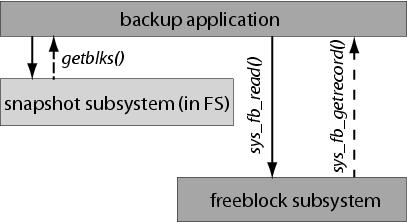
Figure 1: Snapshot-based backup application. The backup application interacts with the snapshot subsystem to learn which blocks comprise the snapshot in question. It uses the freeblock subsystem to read these blocks from disk. Our backup application uses FreeBSD 5.x's snapshot infrastructure[McKusick02] and our system call API. No changes are required to the FreeBSD snapshot implementation. After a snapshot is taken, the backup application interacts with the snapshot subsystem as shown in Figure 1. First, it gets the list of blocks that belong to the snapshot file. Then, the backup application registers freeblock tasks, via sys_fb_read, to read them. It interactively calls sys_fb_getrecord to wait for reads to complete and get the data. Each successfully read block is sent to the back-up destination, together with its address. The backup application can also be used to create a replica by writing each block directly to the corresponding LBN on the destination LUN. FreeBSD's approach to handling modifications to blocks ``owned'' by a snapshot creates an additional complexity for the backup application. A snapshot implementation can do one of two things when a block is modified. In the first option (``application-copy-on-write''), a new location is chosen for the updated blocks and the snapshot map stays unchanged. Network Appliance's WAFL file system, for example, uses this method[Hutchinson98]. In the second option (``snapshot-copy-on-write''), the original data is copied to a newly allocated block and the snapshot map is modified. FreeBSD uses this second option to avoid disrupting carefully chosen disk assignments. In the evaluation section, we explore the effects of both methods on the backup application. To handle FreeBSD's snapshot-copy-on-write, the backup application needs to check with the snapshot system whether each returned block still has the original desired contents. If not, a new freeblock task to read the relocated block is registered. This procedure continues until all original blocks have been read. Note that we could have changed the snapshot subsystem to automatically abort and re-register tasks for modified blocks, but our intention is to show that the backup application works well even with an unmodified snapshot system. 4.2 Buffer cache cleanerCaches are part of all storage systems, and most are write-back in nature. Data blocks written to the cache are marked dirty and must eventually make their way to the storage device. In most operating systems, including FreeBSD, the cache manager promises applications that data written to the cache will propagate to persistent storage within a certain fixed window of time, often 30 seconds. This persistence policy tries to bound the amount of lost work in the face of a system crash. In many file servers and disk array controllers, cache persistence is not a concern because they utilize battery-backed RAM or NVRAM. But, dirty buffers must still be written to storage devices to make room in the cache for new data. Although these systems do not necessarily need a persistence policy, they still need a cache write-back replacement policy. Cache write-back is a good application for a freeblock subsystem. In most cases, there are no ordering requirements and no immediate-term timeline requirements for dirty blocks. Until a persistence policy or cache space exhaustion is triggered, write-backs are background activities that should not interfere with foreground disk accesses (e.g., cache misses). We modified FreeBSD's cache manager to utilize our in-kernel API. It registers all dirty buffers to be written for free through the use of the fb_write call. Importantly, cache blocks are not locked when the writes are registered; when its getbuffer_fn is called by the freeblock subsystem, the cache manager returns NULL if the lock is not free. When its callback_fn is called, the cache manager marks the associated block as clean. If the freeblock subsystem still has not written a buffer for free when the cache manager decides it must be written (as a consequence of cache replacement or persistence policies), then the cache manager converts the associated write to a foreground request via fb_promote. If a dirty buffer dies in cache, for example because it is part of a deleted file, the task registered to flush it to disk is aborted through fb_abort. 4.3 Layout reorganizerDisk access times are usually dominated by positioning times. Various layout reorganization heuristics have been developed to reduce access times. For example, blocks or files may be rearranged in an organ pipe fashion, or replicated so each read can access the closest replica[Hsu03c, Yu00]. Layout reorganization is a background activity that can be made to fit our programming model. But, doing so requires that the implementer think differently about the problem. In the traditional approach, most work focuses on planning an optimal movement pattern. Because a freeblock subsystem is opportunistic, extensive forward planning is not useful, since one cannot predict which freeblock opportunities will be available when.
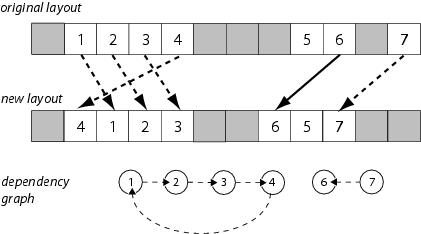
Figure 2: Sample dependency graph for disk layout reorganization. This diagram illustrates the dependency graph that results from changing the disk layout. The gray boxes represent empty physical locations. The white boxes present physical locations that have been mapped to a particular block (identified by the number on the box). Dashed arrows present dependencies whereas solid lines show movements that do not have any dependencies. Planning disk reorganization is difficult because there are dependencies between block movements. If a block is to be moved to a location that currently contains live data, the live data must first be read and either moved or buffered. Although no block can directly depend on more than one other block, dependency chains can be arbitrarily deep or cyclic. Figure 2 illustrates an example of these dependencies.
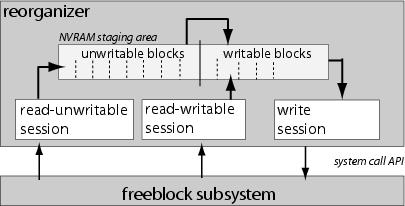
Figure 3: Layout reorganizer architecture. This diagram illustrates the design of the layout reorganizer implemented using our framework. The read-unwritable session manages blocks whose dependencies have not yet been solved. The read-writable session manages all blocks that can be read because their dependencies have been solved. The write-session manages all block writes. All data is temporarily stored in the NVRAM staging area. The reorganization module can break a dependency by reading a block into an NVRAM staging area; once the data has been read from a location, new data can safely be written to that location (note that our experimental system does not actually have NVRAM. Instead, the layout reorganizer just allocates a block of memory and pretends it is non-volatile. This emulates how the reorganizer might work in many modern file servers and disk array controllers). However, the reorganizer can still deadlock if it fills the staging area with blocks that cannot be written to disk because of unresolved dependencies. The goal of the reorganizer is to allow the freeblock system maximum flexibility while avoiding this deadlock case. To accomplish this objective, our reorganizer, illustrated in Figure 3, logically partitions the staging area into two two parts: writable and unwritable. The reorganizer uses three freeblock sessions to move blocks. The ``read-unwritable'' session registers read tasks for all blocks that cannot yet be written, due to a dependency. The ``read-writable'' session registers read tasks for blocks that can either be immediately written after they are read (i.e., they have no dependencies) or that clear a dependency for a currently buffered block. When a read completes, it may eliminate the dependency of another block. If a read-unwritable task is scheduled for this dependent block, the read-unwritable task is aborted (sys_fb_abort) and re-registered as a read-writable task. If the dependent block is already in the staging area, it will be changed from an unwritable block to a writable block. A write is scheduled in the ``write'' session for each writable block in the staging area. When a write completes, its buffer can be released from the staging area and reclaimed. In order to avoid deadlocking, the reorganizer ensures that the number of unwritable blocks in the cache never exceeds a threshold percentage of the cache (the threshold we use is 50%). If the number of unwritable blocks reaches the threshold, the reorganizer suspends (sys_fb_suspend) the read-unwritable session. However, the read-writable session cannot increase the number of unwritable blocks in the staging area, and can be allowed to continue. When the number of unwritable blocks falls below the threshold, because of writes and/or cleared dependencies, the read-unwritable session can be restarted via sys_fb_resume. The reorganizer must suspend both read sessions when the staging area is filled. However, it cannot deadlock because the reorganizer limits the number of unwritable blocks in the staging area, thus assuring that some number of the blocks in the staging area are writable. The reorganizer simply waits until enough of these writable blocks are written out to disk before resuming the read sessions. 5 The freeblock subsystemThis section briefly describes the freeblock subsystem implemented in FreeBSD to experiment with our background applications. This infrastructure supports all the background disk I/O APIs described in Section 3. Details and evaluation of this infrastructure are available in[Thereska03]. 5.1 Architecture and integrationFigure 4 shows the major components of our freeblock subsystem. The background scheduler exports the in-kernel API, and a system call translator component translates the application-level API calls to in-kernel calls. This section describes these pieces and their integration into FreeBSD.
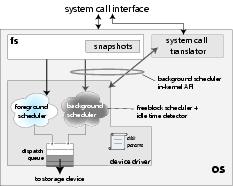
Figure 4: Freeblock subsystem components. Foreground and background schedulers: Our scheduling infrastructure replaces FreeBSD's C-LOOK scheduler. The foreground scheduler uses Shortest-Positioning-Time-First (SPTF), and the background scheduler uses freeblock scheduling (rotational latency gaps and any idle time). Both schedulers use common library functions, based on Lumb et al.'s software-only outside-the-disk SPTF models[Lumb02], for modeling the disk to predict positioning times for requests. Like the original scheduler, our foreground scheduler is called from FreeBSD's dastrategy() function. When invoked, the foreground scheduler appends a request onto the driver's device queue, buf_queue, which is the dispatch queue in Figure 4. It then invokes the background scheduler, which may create and insert one or more freeblock requests ahead of the new foreground request. When a disk request completes at the disk, FreeBSD's dadone() function is called. Into this function, we inserted calls to the background and foreground schedulers. The background scheduler code determines whether the completed request satisfies any freeblock tasks and performs associated processing and clean-up. The foreground scheduler selects a new foreground request, if any are pending, adds it to the dispatch queue, and invokes the background scheduler to possibly add freeblock requests. Then, dadone() proceeds normally. Freeblock system call translator: The system call translator implements the application-level API. Doing so consists of translating system calls to in-kernel calls and managing the flow of data between the freeblock subsystem and the user-level application. When a freeblock task completes, the translator's callback_fn appends a record to the associated session's buffers and, if the buffers were empty, awakens any waiting application processes. When the freeblock subsystem reads data faster than the application processes it, the buffers associated with the session fill up and flow control is needed. When this happens, the translator uses the fb_suspend call, suspending subsequent freeblock requests for the tasks associated with the given session. When the application fetches records and thereby clears space, the translator uses fb_resume to re-enable the associated freeblock tasks. When an application exits or calls sys_fb_close, the translator clears all state maintained by the freeblock system on behalf of the application's session(s). 5.2 Background scheduler algorithmsThe background scheduler includes algorithms for utilizing otherwise wasted rotational latency gaps and for detecting and using disk idle time. Rotational latency usage: Recall that, during busy disk periods, rotational latency gaps can be filled with background media transfers. Our freeblock subsystem uses algorithms similar to those described by Lumb et al.[Lumb02,Lumb00], modified to use less non-idle CPU time and to support fairness and priorities among freeblock sessions. The search for suitable background transfers proceeds in two phases. The first phase checks only a few tracks for potential background transfers adding an insignificant amount of computation (less than 8%) to a busy CPU. The second phase only runs when the CPU is otherwise in the idle loop. It searches all other options to refine the best choice found until the request needs to be sent. Prior algorithms greedily scheduled freeblock requests, assuming all were equal. As shown in Section 6.6, this can lead to poor behavior when freeblock sessions are mixed. In particular, full disk scans can starve other sessions. We introduce fairness, as well as support for priorities, using a simple form of lottery scheduling[Waldspurger94]. The initial tickets allocated to each session are proportional to its assigned priority. The lottery determines both which pending tasks are considered, since there is limited CPU time for searching, and which viable option found is selected. During the first phase, which runs for a short quanta of time, as described in[Thereska03], cylinders closest to the source and destination cylinders with pending tasks from the winning session are considered. Any option from the winning session found will be selected. In addition, all pending tasks on the destination cylinder and within one cylinder of the source are considered; these are the most likely locations of viable options, reducing the odds that the rotational latency gap goes unused. During a second phase, all pending tasks from the winning session are considered and given strict priority over pending tasks from other sessions. Idle time detection and usage: Previous research[Golding95,Ruemmler93] reports that most idle periods are a few milliseconds in length and that long idle time periods come in multi-second durations. Our freeblock subsystem utilizes both. Borrowing from prior work[Golding95], a simple threshold (of 20ms) is used to identify likely idle periods. During short idle times, the scheduler considers pending freeblock reads on the same track. Such data can be read and cached in the device driver with minimal impact on foreground access patterns, because no mechanical delays are induced and no disk prefetching is lost. For each quanta of a long idle period, a session is selected via the lottery. Pending tasks of the winning session are scheduled, starting with the most difficult to service using rotational latency gaps: those near the innermost and outermost cylinders. Algorithm summary: Our outside-the-disk freeblock scheduler has the same ``imperfect knowledge and control'' limitations described by Lumb et al. [Lumb02], and thereby loses about 35% of the potential free bandwidth. An implementation embedded in a disk drive could be expected to provide correspondingly higher free bandwidth to applications. The introduction of conservative CPU usage further reduces free bandwidth utilization by 5--10%. Our evaluations show that the remaining free bandwidth is adequate for most background applications. Detailed description and evaluation of the freeblock subsystem's data structures and algorithms are available in[Thereska03]. 6 EvaluationThis section evaluates how effectively the framework supports the three background applications. 6.1 Experimental setupAll experiments are run on a system with a dual 1GHz Pentium III, 384MB of main memory, an Intel 440BX chipset with a 33MHz, 32bit PCI bus, and an Adaptec AHA-2940 Ultra2Wide SCSI controller. Unless otherwise stated, the experiments use a Seagate Cheetah 36ES disk drive with a capacity of 18GB and results are averaged from at least five runs. Two implementations of the freeblock subsystem are used: one in the FreeBSD device driver and one in user-level Linux. The user-level Linux implementation can either do direct SCSI reads and writes or communicate with a simulated storage device implemented by DiskSim[Bucy03]. All implementations use the same scheduling core and conservatism factors used in the FreeBSD implementation. Three benchmarks are used throughout the evaluation section. The synthetic benchmark is a multi-threaded program that continuously issues small (4KB-8KB) read and write I/Os to disk, with a read-write ratio of 2:1, keeping two requests at the disk queue at all times. The TPC-C benchmark[TPCCdoc] simulates an on-line transaction processing database workload, where each transaction consists of a few read-modify-write operations to a small number of records. We ran TPC-C on the Shore database storage manager[Carey94]. We configured Shore and TPC-C to use 8KB pages, a 32MB page buffer pool, 50 warehouses (covering approximately 70% of the Seagate disk's capacity) and 10 clients per warehouse. The Shore volume is a file stored in FreeBSD's FFS file system. Thus, an I/O generated by Shore goes through the file system buffer cache. Performance of a TPC-C benchmark is measured in TPC-C transactions completed per minute (TpmC) The Postmark benchmark[Katcher97] was designed to measure the performance of a file system used for electronic mail, netnews and web-based services.It creates a large number of small files and performs a specified number of transactions on them. Each transaction consists of two sub-transactions, with one being a create or delete and the other being a read or append. The default configuration used for the experiments consists of 100,000 transactions on 800,000 files in 10,000 directories. File sizes range from 10KB to 20KB. The biases are Postmark's defaults: read/append=5, create/delete=5. 6.2 Freeblock subsystem effectivenessThis section briefly evaluates the freeblock subsystem's effectiveness. Figure 5 shows the efficiency of the freeblock subsystem, as a function of disk utilization, with the synthetic benchmark as the foreground application. A background disk scan registers a freeblock task to read every block of the disk. The callback_fn re-registers each block as it is read, thus maintaining a constant number of blocks wanted. The synthetic benchmark is modified slightly so that the number of I/Os per second can be varied; the request inter-arrival times are exponentially distributed with uniform means.
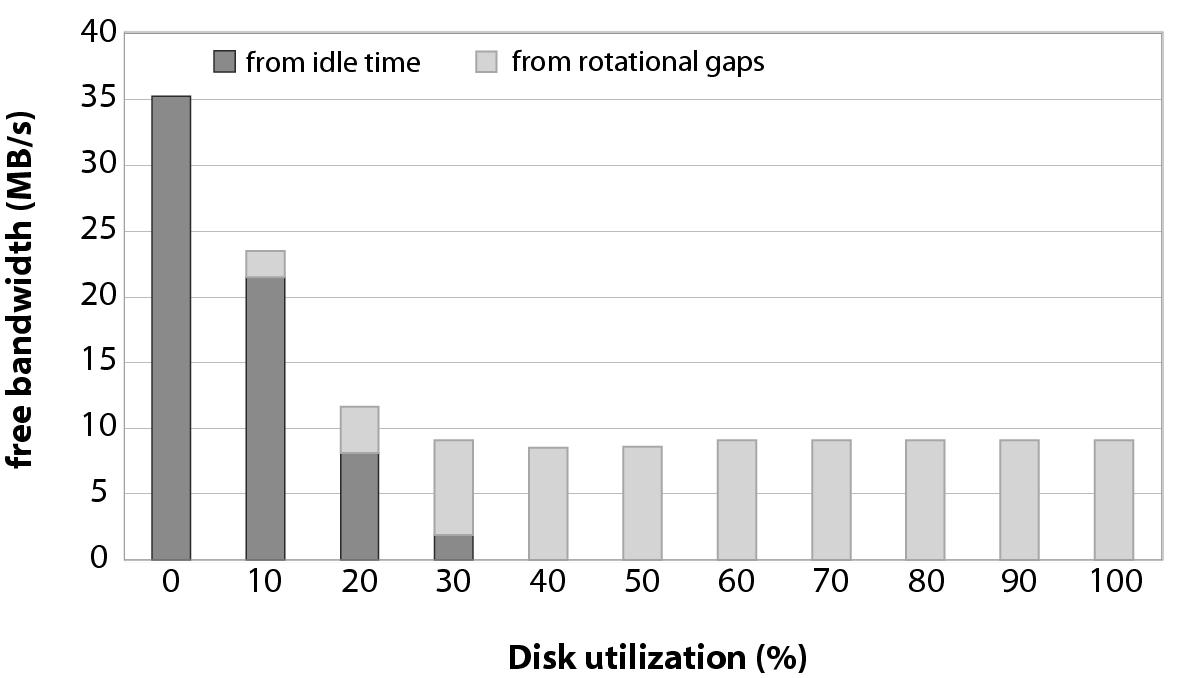
Figure 5: Freeblock subsystem efficiency. This diagram illustrates the instantaneous free bandwidth extracted for a background disk scan as a function of the disk's utilization. When the foreground workload is light, idle time is the main source of free bandwidth. When the foreground workload intensifies, the free bandwidth comes from rotational latency gaps. The freeblock subsystem ensures that background applications make forward progress, irrespective of the disk's utilization. As expected, the progress is fastest when the disk is mostly idle. The amount of free bandwidth is lowest when the system is 40-60% utilized, because short idle times are less useful than either rotational latency gaps or long idle times. Regardless of utilization, foreground requests are affected by less than 2%. For a full evaluation of the freeblock infrastructure and algorithms, please refer to[Thereska03]. 6.3 Snapshot-based backupThis section evaluates the backup application described in Section 4.1. We evaluate both the application-copy-on-write (application-COW) and snapshot-copy-on-write (snapshot-COW) strategies in the FreeBSD kernel. When application-COW is used, all subsequent modifications to a block that the snapshot claims are sent to a new location. When snapshot-COW is used, all subsequent modifications go to the original location of the block, and the snapshot system makes a private copy of the block for itself. The native snapshot implementation in FreeBSD supports only snapshot-COW; we instrumented the kernel so that we could evaluate application-COW as well. Figure 6 shows the performance of our backup application when sharing the system with the three foreground benchmarks. The table beneath the graph shows that the impact of the concurrent backup on foreground performance is less than 2%. During the synthetic benchmark, the backup is completed faster than during Postmark or TPC-C. This is so because the synthetic benchmark's requests are uniformly distributed around the disk, maximizing the scheduler's opportunities. The backup is slightly faster under TPC-C than under Postmark for several reasons. First, Postmark is single-threaded and has short disk idle periods, but that are too short to be exploited. Thus, fewer freeblock opportunities arise during any given time period. Second, the cache manager successfully coalesces many small dirty buffers for Postmark and thus issues larger I/Os to the device, which reduces the effectiveness of freeblock scheduling further.
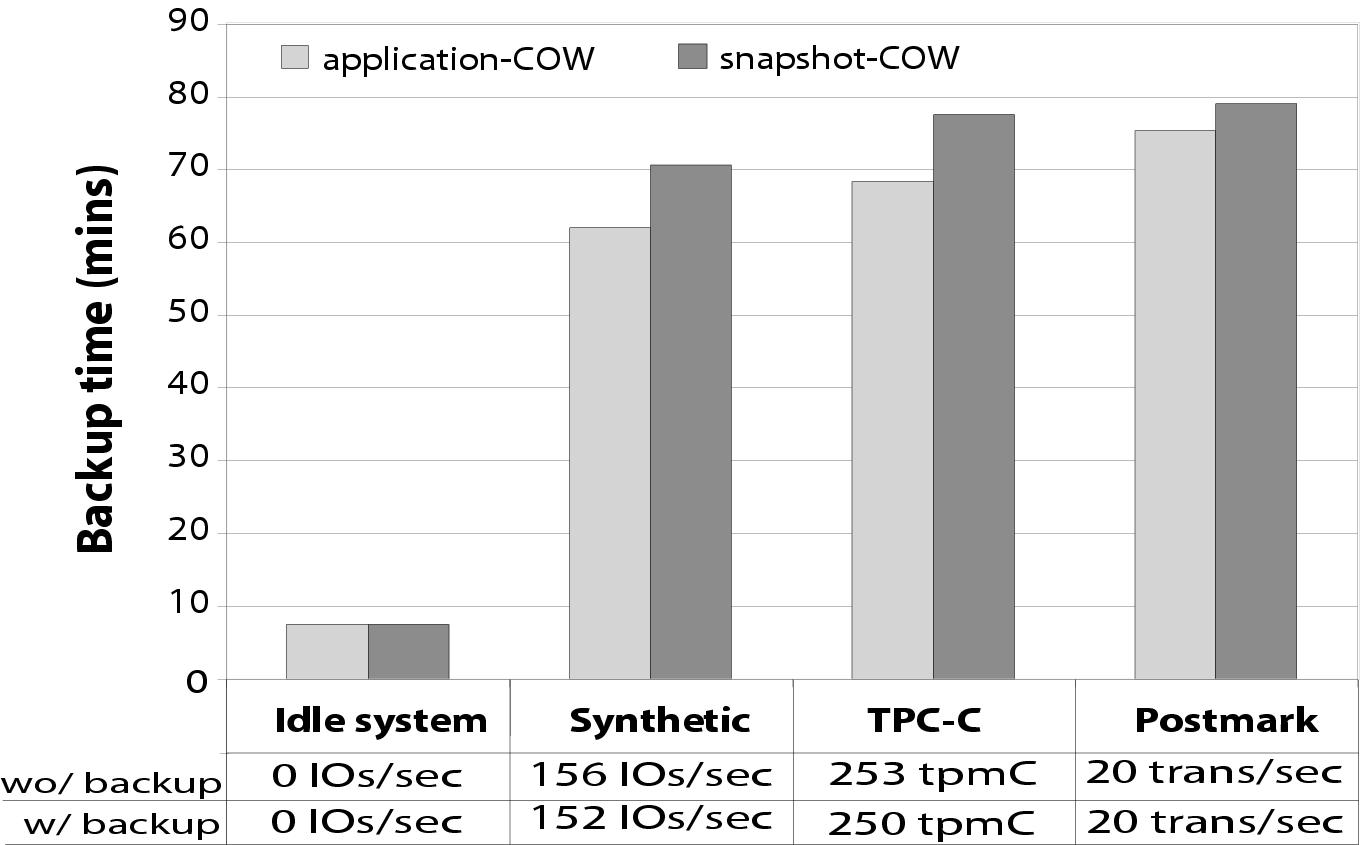
Figure 6: Snapshot-based backup efficiency. This diagram illustrates the efficiency of the backup application when backing up 70% of the Cheetah 36ES disk (18GB). The foreground workload is affected less than 2% during the background backup as a result of access time mispredictions that result from the outside-the-disk implementation of freeblock scheduling. In the idle time case, the streaming bandwidth is about 35MB. The reported streaming bandwidth of the disk is 40MB/s. But, due to head switch delays when changing tracks, the observed streaming bandwidth is about 35MB/s. The backup completes in little over 8 minutes in that case. The graph also shows that the application-COW results in more efficient use of free bandwidth. This is because, with snapshot-COW, the backup application wastes some bandwidth reading blocks that have been modified; it then needs to re-register reads for the new locations of those blocks. The overall effect however, is less then a 15% increase in the time to complete the backup. Thus, a backup application based on our framework can be effective with whichever implementation is used by a particular system. 6.4 Buffer cache cleanerWe evaluate the efficiency of the buffer cache cleaner designed using our framework with both controlled experiments (using the Linux user-level implementation with a simulated cache and direct SCSI reads and writes on the Seagate disk) and the implementation in FreeBSD. The controlled experiments are used to understand the relationship between the efficiency of the cache cleaner and the size of the cache, the workload presented, and the replacement and persistence policies. The metrics of interest are the percentage of dirty blocks cleaned for free and the reduction in average response time of other requests. In all buffer cache experiments, the idle-time detector does not detect enough idle time to be helpful. The controlled experiments use a version of the synthetic benchmark. As indicated, we vary the read-write ratio and the simulated cache size while keeping the size of the requests the same (4KB-8KB). Effect of cache size and read-write ratio: Figure 7 shows the efficiency of the cleaner and its impact on the overall response time as a function of the workload's read-write ratio and the cache size. The replacement policy is least-recently used (LRU), and the persistence policy guarantees that no dirty buffer will stay dirty for longer than 30 seconds. High and low water-marks are used to address space exhaustion: whenever the number of dirty buffers in the cache hits the high water-mark, the cache manager cleans up as many buffers as needed until the low water-mark is reached. Mimicking the notation used by FreeBSD's cache manager, a syncer daemon implements the persistence policy, and a buffer daemon implements the logic that checks the high and low water-marks.
Figure 7: Free cache cleaning with LRU replacement and syncer daemon. These graphs illustrate the efficiency of freeblock scheduling and the impact it makes on the average response time of reads given a LRU replacement policy and a syncer daemon that guarantees no dirty block will stay dirty for longer than 30 seconds. The x-axis contains the cache size and the read-write ratio. A read-write ratio of 0 means that all requests are writes. Several observations can be made from Figure 7. First, as the read-write ratio increases, a larger percentage of the dirty buffers can be cleaned for free, because more and more freeblock opportunities are created. Writes do not go to disk immediately because of write-back caching. Instead, they go to disk as a result of the syncer's work or buffer daemon's work. In both cases, they go to disk in large bursts. Hence, the foreground scheduler (using SPTF) does a good job in scheduling, reducing the freeblock scheduler's chances of finding rotational gaps to use. Second, as the read-write ratio increases (beyond 1:2), the impact of free cleaning on the average response time decreases. This is a direct consequence of the decreasing number of writes (and, hence, dirty buffers) in the system. Third, the efficiency of the freeblock subsystem slightly decreases with increasing cache size. The reason is that every time the syncer or buffer daemons wake up, they have a larger number of dirty buffers to flush. Again, the foreground scheduler reduces the freeblock scheduler's chances of finding rotational gaps to use. However, we observed that the opposite happens, i.e. the efficiency of the scheduler increases, when no persistence policy is used. Effect of replacement and persistence policies: Figure 8 examines the efficiency of the cache cleaner and its impact on the average response time under different replacement policies. The cache size is kept fixed (512MB) and the read-write ratio is 1:1. In addition to LRU, two other replacement policies are evaluated. The SPTF-Evict policy is similar to LRU, but instead of replacing dirty entries in an LRU fashion, the entries closest to the disk head position are replaced first. The FREE-CLEAN (FC) policy chooses to replace a clean entry that has been recently cleaned for free (if none exists, it reverts to LRU). By replacing a clean entry from the cache, FREE-CLEAN attempts to let the remaining dirty buffers stay a little longer in the system so that they may be written out for free.
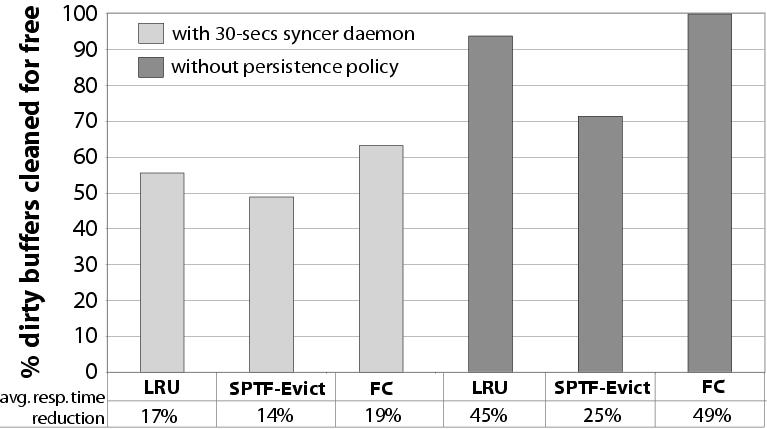
Figure 8: Comparison of replacement and persistence policies. These graphs illustrate the efficiency of the cache cleaner on a system under different replacement and persistence policies All three replacement policies are evaluated with, and without, a syncer daemon. A syncer daemon places a hard limit (30 seconds in our case) on the time the freeblock subsystem has to clean any dirty buffers for free. Hence, fewer buffers are cleaned for free under this policy, irrespective of the replacement policy used. A cache comprised of non-volatile RAM, on the other hand, does not need such a persistence policy. The SPTF-Evict policy reduces the effectiveness of the freeblock subsystem most, thereby reducing its benefit to the average response time. This is because no write task can be satisfied during write I/Os that happen as a result of the buffer daemon (because the dirty buffer closest to the disk head is written first, there are no other dirty buffers freeblock scheduling can squeeze in between foreground requests). Write tasks can still be satisfied during write I/Os that happen because of the syncer daemon. In the case when no syncer daemon is used, all writes happen due to the buffer daemon, hence dirty buffers can be cleaned for free only during foreground read requests. FC is the best policy as far as the cache cleaner is concerned. By leaving the dirty buffers in the cache a little longer, it can clean more of them for free. But, there could be a detrimental effect on cache hit rate, and the cache cleaning benefit observed is quite small.
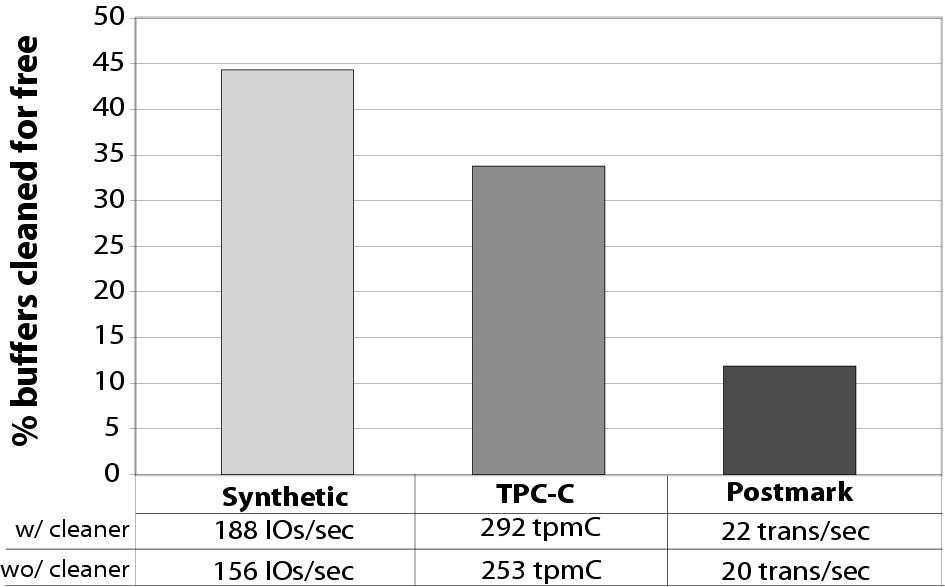
Figure 9: Cache cleaner efficiency in FreeBSD. The throughput metrics below each bar show overall performance with and without free write-backs. Cache cleaning in FreeBSD Figure 9 illustrates the efficiency of the real cache cleaner, implemented as part of FreeBSD's cache manager. At most, 3/4 of the system's 384MB of RAM are devoted to the I/O buffering subsystem. The read-write ratio of the synthetic benchmark is 1:1, the observed read-write ratio of TPC-C is approximately 1:1, and the observed read-write ratio of Postmark is approximately 1:3. In all three cases, a sizeable percentage of the dirty buffers are cleaned for free. Postmark benefits less than the other benchmarks for the same reasons it lagged in the backup evaluation: write-back clustering and unusable short idle periods. 6.5 Layout reorganizerTo evaluate the effectiveness of our reorganizer, we performed a variety of controlled experiments. The foreground workload is the synthetic benchmark, which keeps the disk 100% utilized. To avoid corruption of the FFS file system in FreeBSD, the experiments are run in the user-level Linux environment. In all experiments, the base unit the reorganizer is interested in moving at any time is 8KB (specified by the blksize parameter). Three different reorganization actions are explored. Random reorganization: Random 8KB blocks on the disk are moved to other random locations. Few blocks have dependencies using this method. Circular random reorganization: A list of unique random 8KB blocks is created, and each block is moved to the location of the next block in the list. This creates the longest dependency chain possible: one including every block to be reorganized. Track shuffling: Similar to the random block reorganization action above, but whole tracks are shuffled instead of blocks.
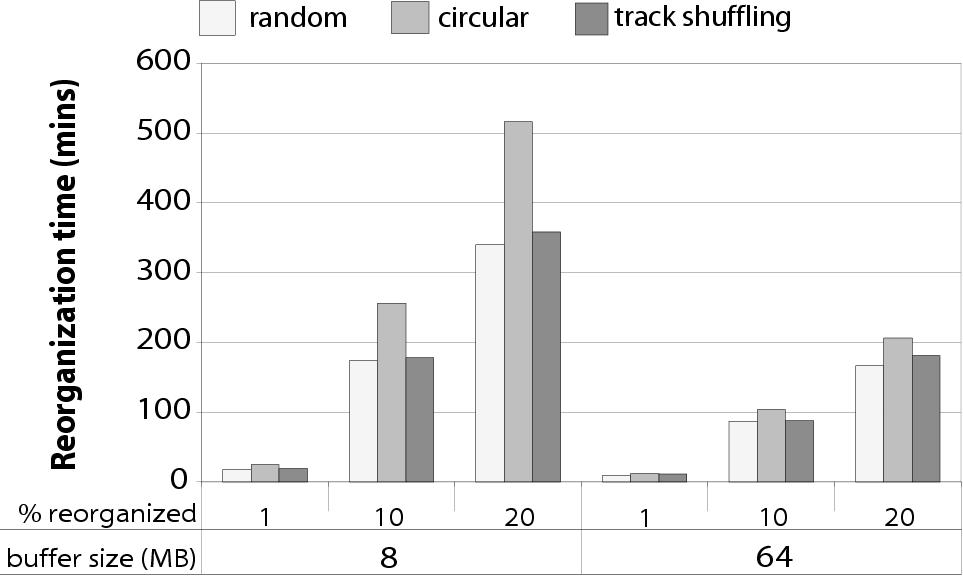
Figure 10: Layout reorganizer efficiency. Each bar cluster shows the time required for the three reorganization actions for a different staging buffer capacity and percentage of the disk space being reorganized. We evaluated each action reorganizing from 1% to 20% of the disk. Research on reorganization techniques indicates that this range is generally the most effective amount of the disk to reorganize[Akyurek92,Hsu03]. The results are shown in Figure 10. Tests with more dependencies, like circular, take longer than those with few dependencies. They also benefit more from an increase in buffer size. The results are encouraging, showing that up to 20% of the disk can be reorganized in a few hours on a fully busy disk. 6.6 Application fairness and prioritiesThis section briefly evaluates the fairness of the scheduling algorithms. Two applications compete for the free bandwidth: a simple disk scrubber and the cache cleaner evaluated above. The disk scrubber simply tries to read all blocks of the disk once, without worrying about consistency issues (hence it doesn't use the snapshot system). The experiment is run until the disk scrubber has read all blocks of the 18GB Seagate disk. The bandwidths dedicated to the scrubber and cache cleaner applications are measured. In the original case, the freeblock scheduler's fairness mechanisms are disabled and the scheduling algorithms lean toward a greedy approach. In the fair system, lottery scheduling makes sure that both applications are treated fairly. Both applications are assigned the default priority. The cache size is fixed at 512MB, the replacement policy is LRU, and the persistence policy is implemented using the 30-sec syncer daemon. The read-write ratio of the foreground workload is 1:1.
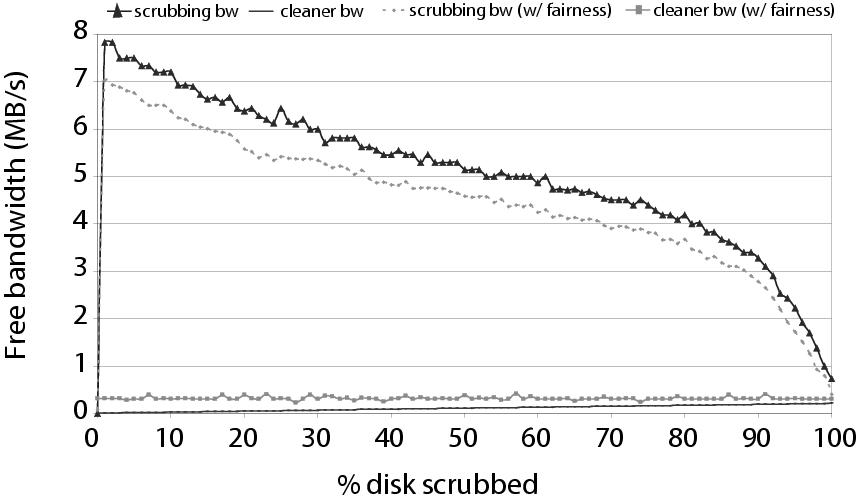
Figure 11: Disk scrubbing and cache cleaning. This figure shows two concurrent background applications, disk scrubbing and cache cleaning, in a system with and without fairness. Figure 11 shows the distribution of bandwidth with and without fairness. The bandwidth given to the cache cleaner increases from almost nothing to about 0.3MB/s when priorities are used. This bandwidth is very close to 0.34MB/s, which is the bandwidth the cache cleaner would get if it were the only background application in the system. The bandwidth of the scrubber, on the other hand, falls by a little more than the gained bandwidth of the cache cleaner. This 2-5% loss in efficiency can be attributed to the scheduler's decision to treat the cache cleaner in a fair manner, thereby spending an equal time searching for opportunities that satisfy tasks of that application. These opportunities are smaller when compared to the opportunities of the scrubber. 7 SummaryThis paper describes a programming framework for developing background disk maintenance applications. With several case studies, we show that such applications can be adapted to this framework effectively. A freeblock subsystem can provide disk access to these applications, using freeblock scheduling and idle time, with minimal impact on the foreground workload. AcknowledgementsWe thank Vinod Das Krishnan, Steve Muckle and Brian Railing for assisting with porting of freeblock scheduling code into FreeBSD. Special thanks to Chet Juszczak (our shepherd) and to all anonymous reviewers who provided much constructive feedback. We also thank the members and companies of the PDL Consortium (including EMC, Hewlett-Packard, Hitachi, IBM, Intel, LSI Logic, Microsoft, Network Appliance, Oracle, Panasas, Seagate, Sun, and Veritas) for their interest, insights, feedback, and support. This work is funded in part by NSF grants CCR-0113660 and CCR-0205544. |
|
This paper was originally published in the
Proceedings of the 3rd USENIX Conference on File and Storage Technologies,
Mar 31-Apr 2, 2004, San Francisco, CA, USA Last changed: 17 March 2004 aw |
|